The Starfish Galaxy is an irregular galaxy located 351.9 million light years away in the constellation Ophiuchus. It has an apparent magnitude of 12.8 and an angular size of 2.1 by 1.1 arcminutes. It is listed as NGC 6240 in the New General Catalogue.
The Starfish Galaxy has a diameter of 242,900 light-years. It is the remnant of a collision of three smaller galaxies that will eventually become a single larger elliptical galaxy.
As a result of the merger, the cosmic Starfish has a highly disturbed structure with several faint loops and extensions and three distinct nuclei. It represents a late stage in the merger of two or more galaxies. The galaxy merger will last more than a billion years. NGC 6420 is estimated to have about 10 to 20 million years left to complete the collision phase.
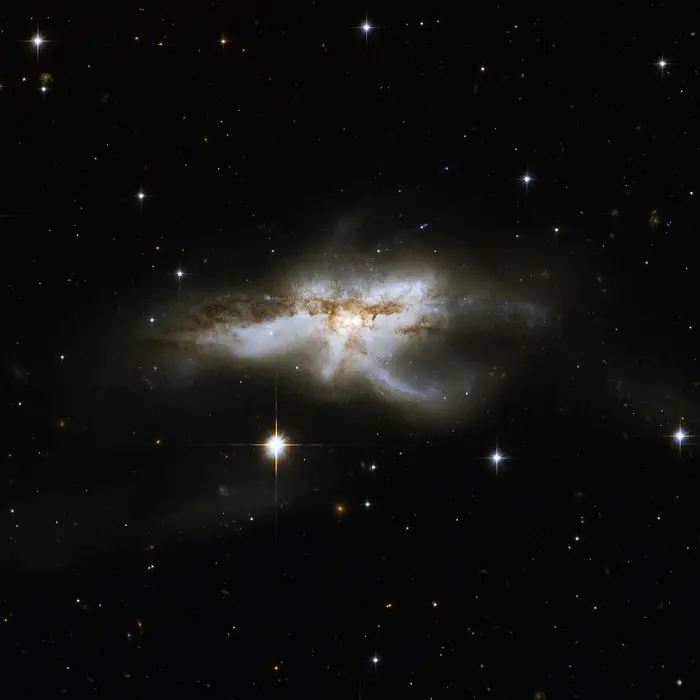
Not all galaxies are neatly shaped, as this NASA/ESA Hubble Space Telescope image of NGC 6240 clearly demonstrates. Hubble previously released an image of this galaxy back in 2008, but the knotted region, shown here in a pinky-red hue at the centre of the galaxies, was only revealed in these 2015 observations from Hubble’s Wide Field Camera 3 and Advanced Camera for Surveys. This galaxy has an elongated shape with branching wisps, loops and tails. This mess of gas, dust and stars bears more than a passing resemblance to a butterfly and, though perhaps less conventionally beautiful, a lobster. This bizarrely-shaped galaxy did not begin its life looking like this; its distorted appearance is a result of a galactic merger that occurred when two galaxies drifted too close to one another. This merger sparked bursts of new star formation and triggered many hot young stars to go out as supernovae. A supernova was discovered in this galaxy in 2013, named SN 2013dc. It is not visible in this image, but its location is indicated here. At the centre of NGC 6240 an even more interesting phenomenon is taking place. When the two galaxies came together, their central black holes did so too. There are two supermassive black holes within this jumble, spiralling closer and closer to one another. They are currently only some 3000 light-years apart, incredibly close given that the galaxy itself spans 300 000 light-years. This proximity secures their fate as they are now too close to escape each other and will soon form a single immense black hole. Image credit: NASA, ESA, the Hubble Heritage (STScI/AURA)-ESA/Hubble Collaboration, and A. Evans (University of Virginia, Charlottesville/NRAO/Stony Brook University) (CC BY 4.0)
NGC 6240 is classified as an ultraluminous infrared galaxy (ULIRG). It has a luminosity of more than 1012 solar luminosities. Ultraluminous infrared galaxies are abnormally bright in the infrared part of the spectrum. The infrared dust emission is attributed either to regions of intense star formation or active galactic nuclei (AGNs) with central supermassive black holes, or both.
ULIRGs have been proposed to be a late phase in evolutionary galaxy mergers of two or more spiral galaxies. In terms of galactic evolution, ULIRGs are followed by quasars – exceptionally luminous active galactic nuclei (AGNs) – and elliptical galaxies, the final products of galactic mergers.
The Starfish Galaxy is one of the nearest ULIRGs to the Milky Way. It has been studied extensively as a key example of its class.
Observations with the Advanced CCD Imaging Spectrometer (ACIS-S) instrument aboard the Chandra X-ray Observatory in 2002 revealed strong hard X-ray emission that coincides with two optical-infrared nuclei of NGC 6240. A team of astronomers led by Stefanie Komossa of the Max Planck Institute for Extraterrestrial Physics in Germany associated the emission with starburst-driven superwind activity. The researchers found both nuclei to be active and sources of luminous hard X-ray emission.
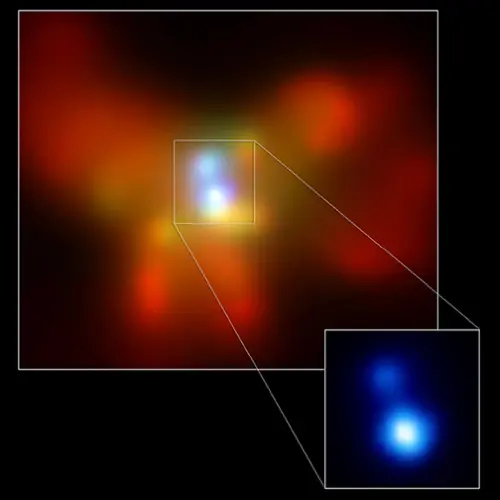
The Chandra image of NGC 6240, a butterfly-shaped galaxy that is the product of the collision of two smaller galaxies, revealed that the central region of the galaxy (inset) contains not one, but two active giant black holes. Previous X-ray observatories had shown that the central region was an X-ray source, but astronomers did not know what was producing the X-rays. Radio, infrared, and optical observations had detected two bright nuclei, but their exact nature also remained a mystery. Chandra was able to show that the X-rays were coming from the two nuclei, and determine their X-ray spectra. These cosmic fingerprints revealed features that are characteristic of supermassive black holes – an excess of high-energy photons from gas swirling around a black hole, and X-rays from fluorescing iron atoms in gas near black holes. Over the course of the next few hundred million years, the two supermassive black holes, which are about 3000 light years apart, will drift toward one another and merge to form one larger supermassive black hole. This detection of a binary black hole supports the idea that black holes grow to enormous masses in the centers of galaxies by merging with other black holes. NGC 6240 is a prime example of a “starburst” galaxy in which stars are forming, evolving, and going out as supernovae at an exceptionally rapid rate due to a relatively recent merger (30 million years ago). Heat generated by this activity created the extensive multimillion degree Celsius gas seen in this image. Credit: NASA/CXC/MPE/S.Komossa et al. (PD)
Facts
The Starfish Galaxy was discovered by the French astronomer Édouard Stephan on July 12, 1871. Danish astronomer John Louis Emil Dreyer, who compiled the New General Catalogue in 1888, described NGC 6240 as “very faint, pretty large, a little extended, diffuse.”
The double nucleus was first reported by J. W. Fried and H. Schulz of the Max Planck Institute for Astronomy in 1982. The astronomers discovered the binary nucleus after observations with the 2.2-m and 1.2-m telescopes at the Calar Alto Observatory in Spain. They found that the two nuclei had angular sizes of 2.5 and 1.5 arcseconds, that they were separated by 1.8 arcseconds and oriented at a position angle of 10 degrees. The study was published in Astronomy and Astrophysics in February 1983.
The third nucleus in NGC 6240 was detected in 2019. An optical 3D spectroscopic study of the central region of the galaxy resulted in the discovery of three nuclei in the final stage of merging. The nuclei were reported to lie in a region 1 kiloparsec across.
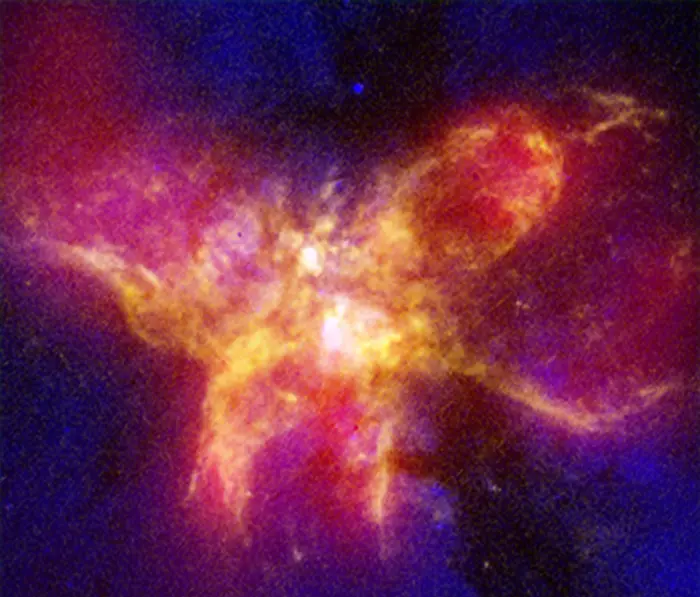
This image shows a composite of the Optical and X-ray data of the galaxy NGC 6240. The optical data (in yellow and blue) were taken by the Wide-Field Planetary Camera 2 aboard the Hubble Space Telescope. The Chandra data covers the same field of view of the galaxy’s central region. The colors in the X-ray image show the intensity of the low (red), medium (green) and high (blue) energy X-rays. For the first time, Chandra has clearly revealed two supermassive black holes in the core of the galaxy. Credit – X-ray: NASA/CXC/MPE/S.Komossa et al.; Optical: NASA/STScI/R.P.van der Marel & J.Gerssen (PD)
The team of astronomers who discovered the third nucleus were led by Wolfram Kollatschny of the Institute for Astrophysics in Göttingen. They observed the galaxy with the MUSE instrument on the Very Large Telescope (VLT) and derived black hole masses of 3.6 ± 0.8 × 108 M☉, 7.1 ± 0.8 × 108 M☉, and 9.0 ± 0.7 × 107 M☉ for the three nuclei. The presence of the triple nucleus indicated that the Starfish Galaxy was a product of three, not two, merging galaxies. Two of the central nuclei are active.
The Starfish Galaxy hosted four observed supernovae in the recent decades. The type IIn supernova SN 2000bg was discovered on April 1, 2000 at the Lick Observatory. It shone at magnitude 17.4. The type Ia supernova SN 2010gp (mag. 17.5) was detected by the CHilean Automatic Supernova sEarch (CHASE) a decade later, on July 14, 2010.
The supernova SN 2013dc was reported by American astrophotographer Adam Block on April 11, 2013. It was classified as a type II-P supernova and had an apparent magnitude of 18.7. The type Ia supernova PSN J16525760+0223367 was spotted by Robert Gagliano, Jack Newton, and Tim Puckett on April 23, 2014. It shone at magnitude 15.8.
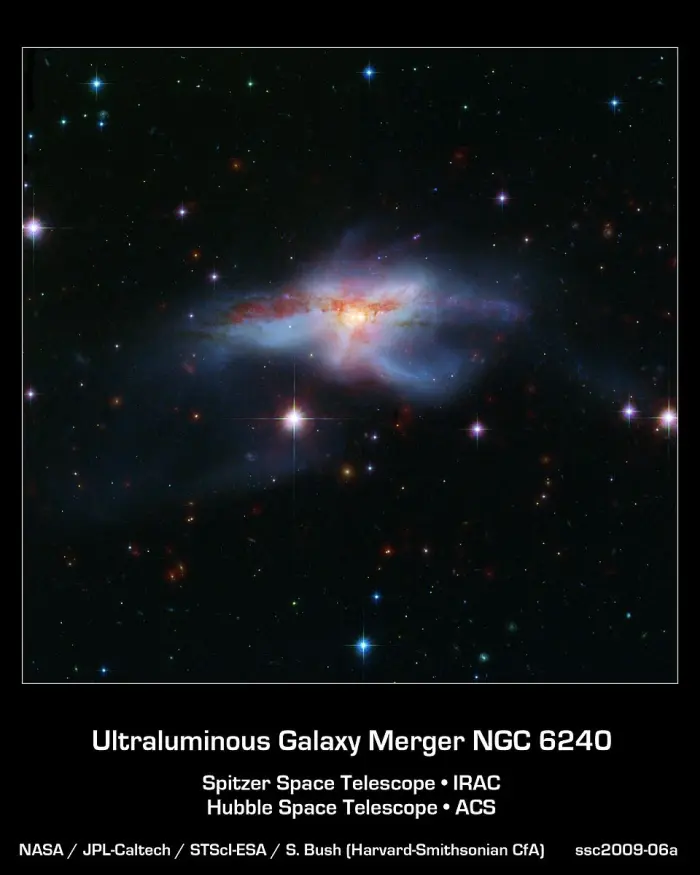
This image of a pair of colliding galaxies called NGC 6240 shows them in a rare, short-lived phase of their evolution just before they merge into a single, larger galaxy. The prolonged collision has drastically altered the appearance of both galaxies and created huge amounts of heat — turning NGC 6240 into an “infrared luminous” active galaxy. A rich variety of active galaxies, with different shapes, luminosities and radiation profiles exist. These galaxies may be related — astronomers have suspected that they may represent an evolutionary sequence. By catching different galaxies in different stages of merging, a story emerges as one type of active galaxy changes into another. NGC 6240 provides an important “missing link” in this process. This image was created from combined data from the infrared array camera of NASA’s Spitzer Space Telescope at 3.6 and 8.0 microns (red) and visible light from NASA’s Hubble Space Telescope (green and blue). Credit: NASA/JPL-Caltech/STScI-ESA/S. Bush (Harvard-Smithsonian CfA) (PD)
Location
The Starfish Galaxy lies within the large polygon of Ophiuchus. It appears roughly a third of the way from Kappa Ophiuchi to Zeta Ophiuchi, close to the intersection of the imaginary lines connecting Kappa and Zeta Ophiuchi and Rasalhague (Alpha Ophiuchi) and Yed Posterior (Epsilon Ophiuchi). The galaxy is best observed in large telescopes.
Rasalhague, the brightest star in Ophiuchus, is the brightest point of light between Vega in the constellation Lyra and Antares in Scorpius. It marks the top of the polygon asterism that dominates the Ophiuchus constellation. Zeta Ophiuchi forms the base of the polygon with Sabik (Eta Ophiuchi), Yed Prior (Delta Ophiuchi) and Yed Posterior (Epsilon Ophiuchi).
Located only 02° 24’ north of the celestial equator, the Starfish Galaxy is visible from both hemispheres for at least part of the year. The best time of the year to observe the deep sky objects in Ophiuchus is during the month of July, when the constellation appears high above the horizon in the early evening.
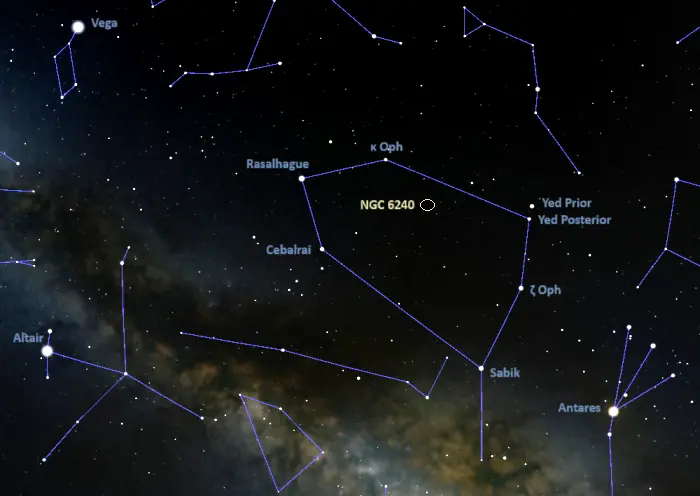
Location of the Starfish Galaxy (NGC 6240), image: Stellarium
Starfish Galaxy – NGC 6240
| Constellation | Ophiuchus |
| Object type | Ultraluminous infrared galaxy (ULIRG) |
| Morphological type | I0 pec |
| Right ascension | 16h 52m 58.8708s |
| Declination | +02° 24′ 03.333″ |
| Apparent magnitude | 12.8 |
| Apparent size | 2.1′ × 1.1′ |
| Distance | 351.9 ± 24.7 million light-years (107.90 ± 7.56 megaparsecs) |
| Size | 242,900 light-years (74,480 parsecs) |
| Redshift | 7287 ± 8 km/s |
| Names and designations | Starfish Galaxy, Rumpled Starfish Galaxy, NGC 6240, IC 4625, UGC 10592, PGC 59186, LEDA 59186, VV 617, MCG +00-43-004, MRC 1650+024, PRC D-28, IRAS 16504+0228, IRAS F16504+0228, IRAS 1650+024P04, 2MASX J16525886+0224035, CGCG 025-011, INTREF 723, GRA B1650+02, BWE 1650+0228, AKARI-IRC-V1 J1652588+022403, 4C 02.44, MITG J165303+0222, GB6 B1650+0228, 87GB 165028.6+022854, GLEAM J165258+022409, JCMTSE J165258.9+022402, JCMTSF J165258.9+022402, NVSS J165258+022403, PBC J1653.0+0223, PKS 1650+024, PKS J1652+0224, PMN J1653+0224, PSCz Q16504+0228, RGB J1653.0+0224, RGB J1652+024, RX J1652.9+0223 , 1RXP J165259.0+022406, 1RXS J165257.9+022353, SDSS J165258.89+022402.8, Z 25-11, Z 1650.5+0229, WISE J165258.89+022403.6, WISEA J165258.89+022403.6, SWIFT J1652.9+0223, SWIFT J1652.9+0223A, SWIFT J1653.2+0224, TXS 1650+024, TGSSADR J165258.7+022403, WB 1650+0228, UZC J165259.0+022407, VLSSr J165257.4+022416, 2XMM J165258.9+022403, 2XMMi J165258.9+022403 |
Images
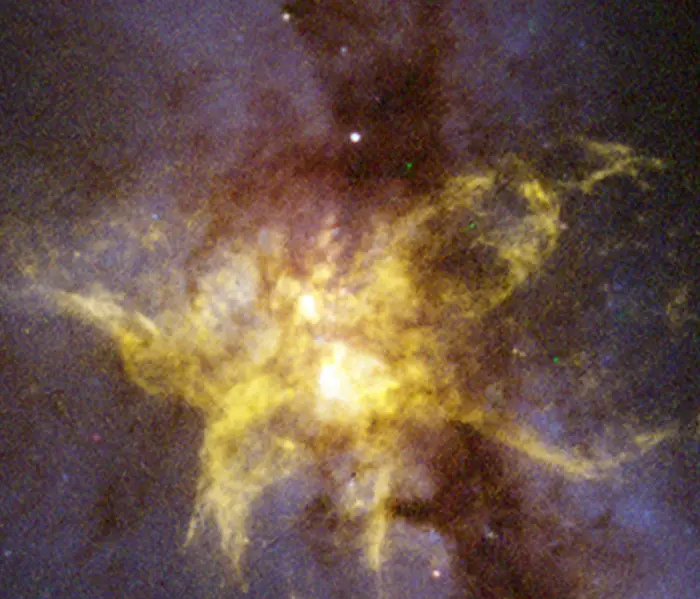
This image shows the central region of the galaxy NGC 6240 in optical wavelengths taken by the Wide-Field Planetary Camera 2 aboard the Hubble Space Telescope. Credit: NASA/STScI/R.P.van der Marel & J.Gerssen (PD)
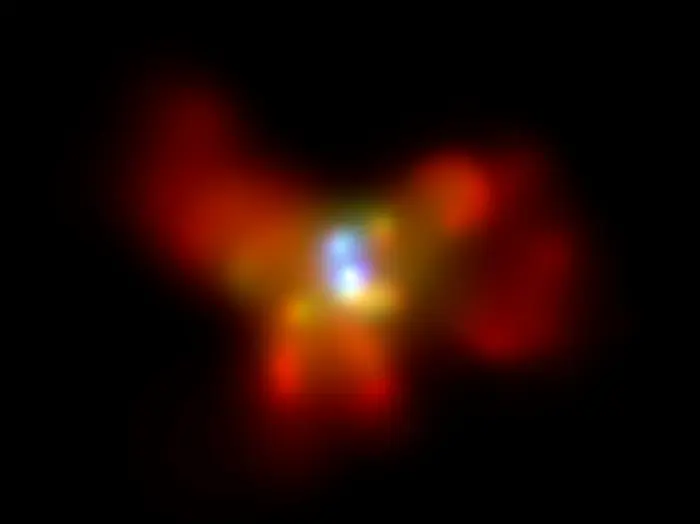
The peculiar butterfly shape of NGC 6240 was caused by the collision of two smaller galaxies. Chandra’s high-resolution image of the galaxy’s central region revealed not one, but two active giant black holes. Over the course of the next few hundred million years, the two supermassive black holes, which are about 3000 light years apart, will drift toward one another and merge to form one larger supermassive black hole. Credit: NASA/CXC/MPE/S.Komossa et al. (PD)
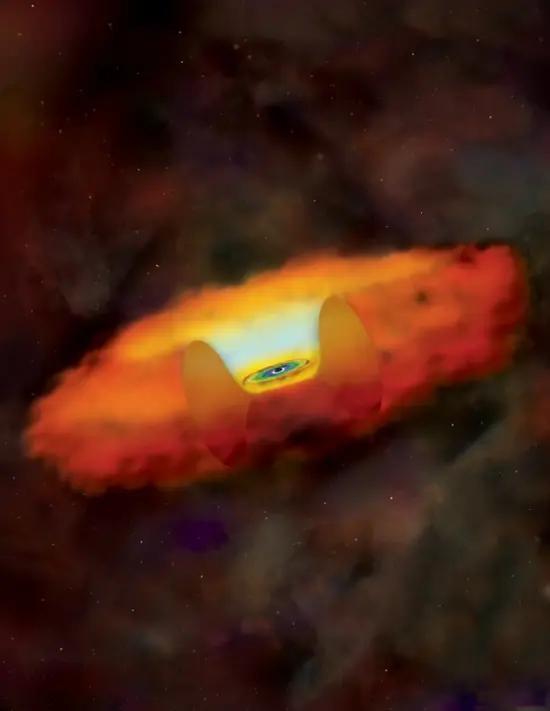
An artist’s conception shows a black hole surrounded by a disk of hot gas, and a large doughnut or torus of cooler gas and dust. The light blue ring on the back of the torus is due to the fluorescence of iron atoms excited by X-rays from the hot gas disk. Image credit: NASA/CXC/M.Weiss (PD)
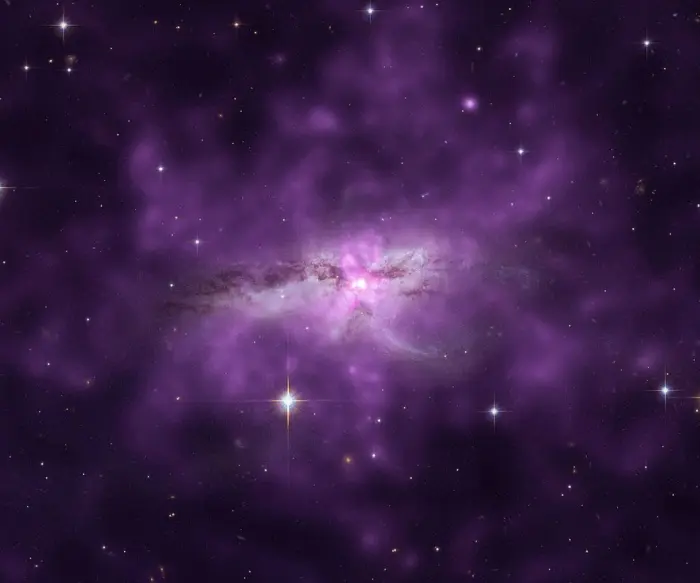
Scientists have used Chandra to make a detailed study of an enormous cloud of hot gas enveloping two large, colliding galaxies in the system known as NGC 6240. This unusually large reservoir of gas contains as much mass as 10 billion Suns, spans about 300,000 light years, radiates at a temperature of more than 7 million degrees, and glows in X-rays (purple). The Chandra data have been combined with optical data from the Hubble, which show long tidal tails from the merging galaxies, extending to the right and bottom of the image. Credit: Chandra X-ray Observatory Center, Smithsonian Institution (PD)